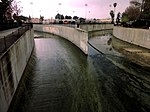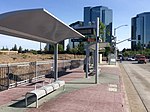De Soto station
2005 establishments in CaliforniaBus stations in Los AngelesCanoga Park, Los AngelesG Line (Los Angeles Metro)Los Angeles Metro Busway stations ... and 5 more
Los Angeles Metro stubsPublic transportation in the San Fernando ValleyWikipedia page with obscure subdivisionWinnetka, Los AngelesWoodland Hills, Los Angeles

De Soto station is a station on the G Line of the Los Angeles Metro Busway system. The station is next to Victory Boulevard, which parallels that section of the Orange Line. It is located in the western San Fernando Valley near the meeting of three largely residential municipal communities of the City of Los Angeles: Canoga Park, Winnetka, and Woodland Hills. It is named after the adjacent De Soto Avenue, which travels north-south and crosses the east-west busway route. Counting from the western terminus in Chatsworth, it is the sixth station on the Orange Line.
Excerpt from the Wikipedia article De Soto station (License: CC BY-SA 3.0, Authors, Images).De Soto station
De Soto Avenue, Los Angeles Warner Center
Geographical coordinates (GPS) Address Nearby Places Show on map
Geographical coordinates (GPS)
| Latitude | Longitude |
|---|---|
| N 34.1886 ° | E -118.5884 ° |
Address
De Soto Avenue
De Soto Avenue
91371 Los Angeles, Warner Center
California, United States
Open on Google Maps









